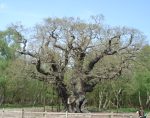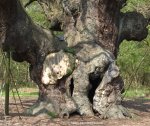Categories
Calendars
Guides
Reviews
Archive
Gallery
Articles
Ask Our Gardening Expert
The Major Oak
HOW HAS IT GROWN? The huge girth of the main trunk (10 metres / 33 feet),
combined with the shape of the tree is probably caused by two or three
oaks growing together as one. The cavity of the oak has several
compartments which also lends weight to this theory. The age of the tree is not known exactly. but it is
believed to be at least 800 years old. Because the centre of the tree
has been eaten away by bactria and fungi normal dating techniques do not
apply. Some people believe the tree is over a thousand years old. WHAT'S IN THE NAME? This name fell out of favour and the tree became known
as the Queen's Oak in the early 1800s. The tree has no know association
with any Queen of England. Finally, in 1790,Major Hayman Rooke wrote and published
a book on oak trees in Welbeck Park, Nottinghamshire. Picture 9 in the
book clearly shows the Queen's Oak. From then on, this tree was named
the Major's Oak (shortened to Major Oak). INTERESTING FACTS
The sheer size of the tree is remarkable. It has a height of 19 meters
(52 feet), the girth of the main trunk is 10 meters (33 feet) and the
spread of the branches and leaves is 28 metres (92 feet). The number of visitors to the tree each year is
currently estimated to be 900,000, one very good reason why it is now
fenced off. The Major Oak still produces good crops of acorns every
three or four years. In a good year it will produce over 150,000 acorns! Many famous people are known to have visited the Major
Oak including Jason Connery and Michael Praed both of whom have starred
in the role of Robin Hood. Other famous visitors include the botanist
David Bellamy, Cilla Black, Bernard Miles, Jack Palance and Maureen
Lipman. SEEING THE MAJOR OAK
Be aware though that parking facilities in the area are
totally inadequate on busy days such as Bank Holidays. Visitors
to the centre are the main revenue source. It is a sign of
appalling short-sightedness on the part of the local councils
not to provide adequate parking. If this involves re-siting the
visitor centre elsewhere then we are fully in favour of that.
This would also reduce damage caused by the existing centre.
Major Oak, click to enlarge
Possibly the most famous tree in England, the Major Oak is thought to be
between 800 to 1,200 years old. It's also the largest oak tree in the
UK.
There are around 500 species of oaks in the world although there are
only two native to the UK. These are the Pendunculate or English Oak and
the Sessile or Durmast Oak. The Major Oak is of the species Pendunculate
Oak (Quercus robur).
Originally this oak tree was called the Cockpen Tree. The reason for the
name is simple. In the middle 1700s cockfighting was at its most
popular. The cavity of the tree had already been formed by that time and
cock birds were stored inside the tree prior to a cockfight. 
The Major Oak is a 15 minute gentle walk from the Sherwood Forest
Visitor Centre,
click here
for a map. When you arrive at the visitor centre, simply follow the
signs for Major Oak.
OTHER RESOURCES
The Sherwood Forest Visitor Centre website gives lots of useful
information on the Major Oak and Sherwood Forest in general.
Click here for their site.